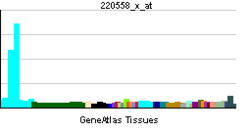TSPAN32
| TSPAN32 | ||||||
|---|---|---|---|---|---|---|
| Identifiers | ||||||
| Aliases | TSPAN32, ART1, PHEMX, PHMX, TSSC6, tetraspanin 32 | |||||
| External IDs | MGI: 1350360 HomoloGene: 10650 GeneCards: TSPAN32 | |||||
| RNA expression pattern | ||||||
 | ||||||
| More reference expression data | ||||||
| Orthologs | ||||||
| Species | Human | Mouse | ||||
| Entrez | ||||||
| Ensembl | ||||||
| UniProt | ||||||
| RefSeq (mRNA) | ||||||
| RefSeq (protein) | ||||||
| Location (UCSC) | Chr 11: 2.3 – 2.32 Mb | Chr 7: 143.01 – 143.02 Mb | ||||
| PubMed search | [1] | [2] | ||||
| Wikidata | ||||||
| View/Edit Human | View/Edit Mouse |
Tetraspanin-32 is a protein that in humans is encoded by the TSPAN32 gene.[3][4][5]
Function
This gene is described as a member of the tetraspanin superfamily whose expression is confined to hematopoietic tissues.[5]
Clinical significance
This gene is one of several tumor-suppressing subtransferable fragments located in the imprinted gene domain of 11p15.5, an important tumor suppressor gene region. Alterations in this region have been associated with the Beckwith-Wiedemann syndrome, Wilms tumor, rhabdomyosarcoma, adrenocortical carcinoma, and lung, ovarian, and breast cancer. This gene is located among several imprinted genes; however, this gene, as well as the tumor-suppressing subchromosomal transferable fragment 4 (TSSC4), escapes imprinting. This gene may play a role in malignancies and disease that involve this region as well as hematopoietic cell function.[5]
References
- ↑ "Human PubMed Reference:".
- ↑ "Mouse PubMed Reference:".
- ↑ Lee MP, Brandenburg S, Landes GM, Adams M, Miller G, Feinberg AP (Apr 1999). "Two novel genes in the center of the 11p15 imprinted domain escape genomic imprinting". Hum Mol Genet. 8 (4): 683–90. doi:10.1093/hmg/8.4.683. PMID 10072438.
- ↑ Nicholson RH, Pantano S, Eliason JF, Galy A, Weiler S, Kaplan J, Hughes MR, Ko MS (Sep 2000). "Phemx, a novel mouse gene expressed in hematopoietic cells maps to the imprinted cluster on distal chromosome 7". Genomics. 68 (1): 13–21. doi:10.1006/geno.2000.6277. PMID 10950922.
- 1 2 3 "Entrez Gene: TSPAN32 tetraspanin 32".
Further reading
- Koi M, Johnson LA, Kalikin LM, Little PF, Nakamura Y, Feinberg AP (1993). "Tumor cell growth arrest caused by subchromosomal transferable DNA fragments from chromosome 11.". Science. 260 (5106): 361–4. doi:10.1126/science.8469989. PMID 8469989.
- Hu RJ, Lee MP, Connors TD, Johnson LA, Burn TC, Su K, Landes GM, Feinberg AP (1998). "A 2.5-Mb transcript map of a tumor-suppressing subchromosomal transferable fragment from 11p15.5, and isolation and sequence analysis of three novel genes.". Genomics. 46 (1): 9–17. doi:10.1006/geno.1997.4981. PMID 9403053.
- Paulsen M, El-Maarri O, Engemann S, Strödicke M, Franck O, Davies K, Reinhardt R, Reik W, Walter J (2000). "Sequence conservation and variability of imprinting in the Beckwith-Wiedemann syndrome gene cluster in human and mouse.". Hum. Mol. Genet. 9 (12): 1829–41. doi:10.1093/hmg/9.12.1829. PMID 10915772.
- Robb L, Tarrant J, Groom J, Ibrahim M, Li R, Borobakas B, Wright MD (2001). "Molecular characterisation of mouse and human TSSC6: evidence that TSSC6 is a genuine member of the tetraspanin superfamily and is expressed specifically in haematopoietic organs.". Biochim. Biophys. Acta. 1522 (1): 31–41. doi:10.1016/s0167-4781(01)00306-2. PMID 11718897.
- Hillman RT, Green RE, Brenner SE (2005). "An unappreciated role for RNA surveillance.". Genome Biol. 5 (2): R8. doi:10.1186/gb-2004-5-2-r8. PMC 395752
 . PMID 14759258.
. PMID 14759258.
External links
- TSPAN32 human gene location in the UCSC Genome Browser.
- TSPAN32 human gene details in the UCSC Genome Browser.